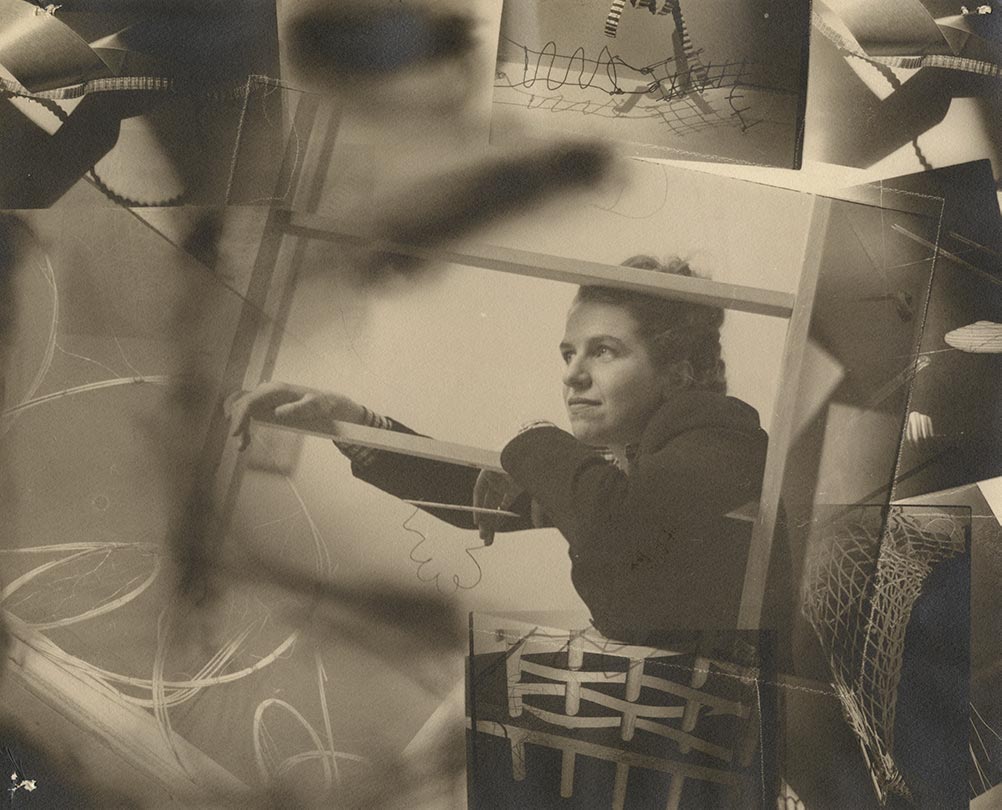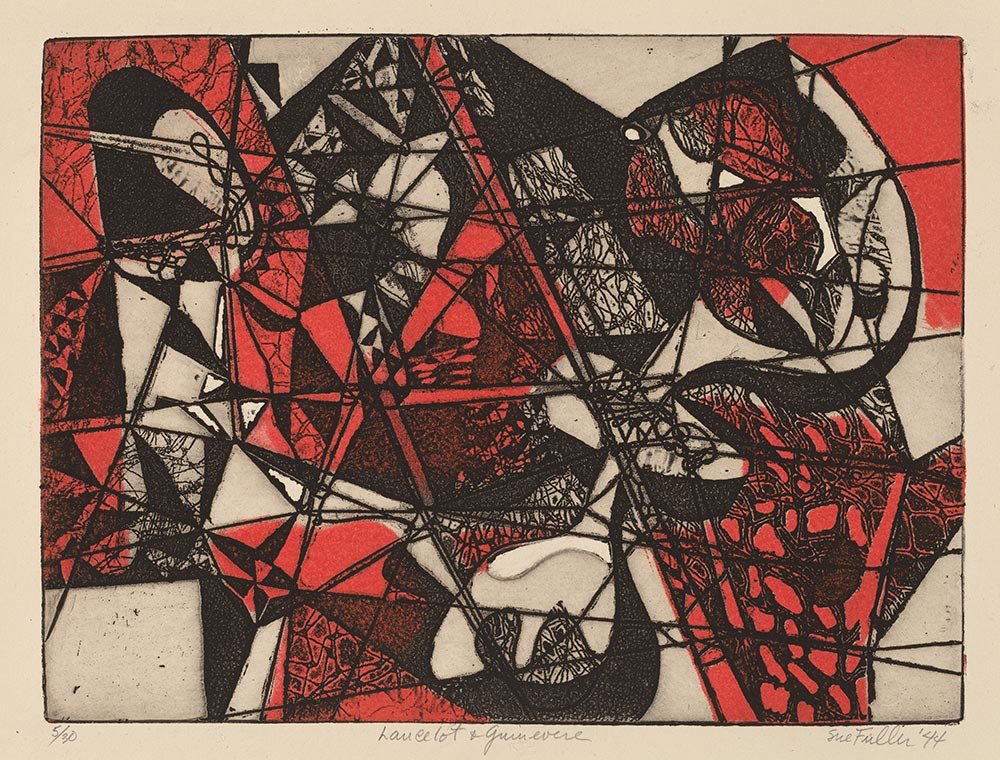34. Sue Fuller
| Life Dates | 1914-2006 |
| Place of Birth | Pittsburgh, PA, USA |
| Place of Death | Southhampton, NY, USA |
| Birth Name | Caroline Sue Fuller |
Sue Fuller was born and raised in Pittsburgh, Pennsylvania, where her father Samuel Fuller was a construction engineer in the “City of Bridges.”1 Her creative prowess was such that her high school art teacher, Kathryn Cherry (1860-1931), invited Fuller to spend the several summers with her in Gloucester, Massachusetts—where she summered—and to study at the Thurn School of Art, a short-lived art school operated by Ernst Thurn (1889-1971).2 Fuller and Thurn stayed in touch, even after she entered college at the Carnegie Institute of Technology, and he invited her to attend classes with Hans Hofmann in the summer of 1934.3 Immediately upon graduating from college in 1936, Fuller pursued graduate studies in fine art at Columbia University’s Teachers College. Coursework with her favorite Columbia professor, the printmaker Arthur R. Young (1920-1990), enabled Fuller to build a solid familiarity with several printmaking techniques. In June 1937, Fuller departed for Europe for the summer months with friends from graduate school, touring the continent extensively. One notable highlight was seeing the modern art on display at the Nazi’s “Degenerate Art” show held in Munich.4 After a brief stint teaching back at her alma mater, Fuller moved back to New York City where she continued making paintings and watercolors in a representational style, while also working in a variety of jobs as a commercial artist, typesetter, department store window display designer, and jewelry designer.
Looking for someone to teach her how to engrave on metal jewelry, Fuller found her way in 1943 to Stanley William Hayter at the New School. Instantly inspired by Atelier 17’s fertile, avant-garde atmosphere, she dropped the query about jewelry design and became enmeshed in the studio’s mission to research new forms of creative expression using the graphic arts. She remained affiliated with the studio for approximately two years. Her prints from this period fall roughly into two categories: images created by stretching premade lace and fabrics into positions, such as Cock, and second, prints made by weaving and knotting string and other found fiber objects to become original textiles, such as Lancelot and Guinevere. The second type of soft ground etching became instrumental to Fuller’s exploration of the artistic possibilities of textiles with the three-dimensional string-wrapped pieces that she made from the mid-1940s onward. She was the recipient of a Louis Comfort Tiffany Fellowship (1948) and a Guggenheim Fellowship (1949), during which time she developed her work on these string compositions. Fuller completed a number of commissioned installations of her string compositions, most notably at the McNay Art Museum and the Unitarian Church of All Souls in New York City.
Archives
Sue Fuller, oral history interview by Paul Cummings, April 24 and May 8, 1975, Archives of American Art, Smithsonian Institution.
Sue Fuller letters to Florence Forst, 1940–94, Archives of American Art, Smithsonian Institution.
Pricilla Cunningham papers regarding Sue Fuller, 1982-2006, Archives of American Art, Smithsonian Institution.
Sue Fuller’s application material, Guggenheim Foundation archives, New York, New York.
Selected Bibliography
Breuning, Margaret. “Sue Fuller.” Art Digest 27 (June 1953): 17.
Broadd, Harry. “The String Constructions of Sue Fuller.” Arts & Activities 91, no. 3 (April 1982): 32–36.
Browne, Rosalind. “Sue Fuller: Threading Transparency.” Art International 16 (January 1972): 37–40.
Crocker, Emerson. Sue Fuller, Prints, Drawings, Watercolors, Collages, String Compositions. San Antonio, TX: Marion Koogler McNay Art Institute, 1967.
F., M. “Sue Fuller.” Art News 48 (April 1949): 48.
Fuller, Sue. “Bringing Up Teacher.” In Art Education Today: An Annual Devoted to the Problems of Art Education, 31–35. New York: Teachers College, Columbia University, 1939.
———. “Mary Cassatt’s Use of Soft-Ground Etching.” Magazine of Art, February 1950, 54–57.
———. “Shall We Scrap the Art Teacher in Time of War.” Design 44, no. 5 (January 1943): 24–25.
———. “Twentieth Century Cat’s Cradle.” Craft Horizons 14 (April 1954): 20–24.
Jones, Stacey V. “Artist Devises a Three-Dimensional Effect.” New York Times, June 21, 1969.
Krasne, Belle. “Fuller Advantage of String.” Art Digest, no. 24 (July 1, 1950): 19.
Kup, Karl. “Sue Fuller.” Print 5, no. 1 (1947): 70.
Lansford, Alonzo. “Sue Fuller in the Village.” Art Digest 21 (March 1, 1947): 19.
Lowengrund, Margaret. “Casein and String.” Art Digest 23 (April 1, 1949): 23.
Maloney-Rose, Mary. “Atelier 17 As Catalyst: Minna Citron and Sue Fuller, 1930-1970.” M.A. thesis, Michigan State University, 1981.
Peter Busa / Sue Fuller. New York: Bertha Schaefer Gallery, 1949.
R., R. “Sue Fuller.” Art Digest 30 (February 1956): 53.
Ritchie, Andrew Carnduff. Abstract Painting and Sculpture in America. New York: Museum of Modern Art, 1951.
Seckler, Dorothy. “Sue Fuller.” Art News 49 (September 1950): 46.
String Compositions, Plastic Embedments, Water Colors, Prints and Collages by Sue Fuller. Mountainville, NY: Storm King Art Center, 1966.
“String Patterns: Artist Works with Colorful Twine.” Life 27, no. 18 (October 31, 1949): 77.
Sue Fuller and the New York Atelier 17: An Exhibition in Honor of Sue Fuller’s 90th Birthday. New York: Susan Teller Gallery, 2004.
“Sue Fuller at the Village Art Center.” Art News 46 (April 1947): 51.
Sue Fuller: Collages, Prints, String Compositions. Washington, DC: The Corcoran Gallery of Art, 1951.
“Sue Fuller Prints.” Village Art Center, March 23, 1947. Smithsonian Institution, National Museum of American History, Special Exhibition File.
Sue Fuller Works on Paper: A Memorial Exhibition. New York: Susan Teller Gallery, 2006.
Taylor, Alex, ed. In Focus: String Composition 128 (1964) by Sue Fuller. London: Tate Gallery, 2018.
“Transparency, Light and Balance.” The Christian Science Monitor, The artist on his work, 6th installment, September 22, 1965, 8.
“Village Graphic Winners.” Arts Magazine 21, no. 6 (December 15, 1946): 9.
Weyl, Christina. “The Printed Collage.” In In Focus: String Composition 128 (1964) by Sue Fuller. London: Tate Gallery, 2018.
Notes
- An excellent source of biographical information is Sue Fuller’s oral history interview with Paul Cummings, April 24 and May 8, 1975. Another excellent, new resource on Fuller is the Tate Gallery’s In Focus: String Composition 128 (1964) by Sue Fuller, published in September 2018. ↩
- Sue Fuller began locally high school at Peabody High School in Pittsburgh, but transferred after a year and a half to a Christian Science boarding school called The Principia in St. Louis, where she met Kathryn Cherry. Apparently, the school drew students from Japan, and Fuller mentioned one of them also came to Gloucester because it was too far to travel back home for the summer. See Fuller’s hand-written document labeled “Personal,” courtesy of Delvin Miller. ↩
- Fuller, oral history. Hofmann spent the summers of 1933 and 1934 in Gloucester, Massachusetts, having been invited by his former student Ernest Thurn. In her oral history interview, Fuller claims she spent the summer plus six additional months in Gloucester. There are indications she, like Dorothy Dehner, did not enjoy her college experience but graduated out of obligation to parents. See “Personal,” courtesy of Delvin Miller. ↩
- This infamous Nazi show ran in Munich from July 19 to November 30, 1937. According to ship manifests, Fuller was in Europe between approximately June 17 and August 25. ↩


